
The honey locust, also known as the thorny locust or thorny honeylocust, is a deciduous tree in the family Fabaceae, native to central North America where it is mostly found in the moist soil of river valleys. Honey locust is highly adaptable to different environments, has been introduced worldwide, and is an aggressive, invasive species.

Robinia pseudoacacia, commonly known in its native territory as black locust, is a medium-sized hardwood deciduous tree, belonging to the tribe Robinieae of the legume family Fabaceae. It is endemic to a few small areas of the United States, but it has been widely planted and naturalized elsewhere in temperate North America, Europe, Southern Africa and Asia and is considered an invasive species in some areas. Another common name is false acacia, a literal translation of the specific name.

The carob is a flowering evergreen tree or shrub in the Caesalpinioideae sub-family of the legume family, Fabaceae. It is widely cultivated for its edible pods, and as an ornamental tree in gardens and landscapes. The carob tree is native to the Mediterranean region and the Middle East. Portugal is the largest producer of carob, followed by Italy and Morocco.

Enterolobium cyclocarpum, commonly known as guanacaste, caro caro, monkey-ear tree or elephant-ear tree, is a species of flowering tree in the pea family, Fabaceae, that is native to tropical regions of the Americas, from central Mexico south to northern Brazil (Roraima) and Venezuela. It is known for its large proportions, its expansive, often spherical crown, and its curiously shaped seedpods. The abundance of this tree, especially in Guanacaste Province, Costa Rica, where it is prized for the shady relief it provides from the intense sun, coupled with its immensity, have made it a widely recognized species. It is the national tree of Costa Rica.

Bauhinia × blakeana, commonly called the Hong Kong orchid tree, is a hybrid leguminous tree of the genus Bauhinia. It has large thick leaves and striking purplish red flowers. The fragrant, orchid-like flowers are usually 10 to 15 centimetres across, and bloom from early November to the end of March. Although now cultivated in many areas, it originated in Hong Kong in 1880 and apparently all of the cultivated trees derive from one cultivated at the Hong Kong Botanical Gardens and widely planted in Hong Kong starting in 1914. It is referred to as bauhinia in non-scientific literature though this is the name of the genus. It is sometimes called the Hong Kong orchid (香港蘭). In Hong Kong, it is most commonly referred to by its Chinese name of "洋紫荊".

Bauhinia variegata is a species of flowering plant in the legume family, Fabaceae. It is native to an area from China through Southeast Asia to the Indian subcontinent. Common names include orchid tree and mountain ebony.

The red-flanked duiker is a species of small antelope found in western and central Africa in countries as far apart as Senegal and Sudan. Red-flanked duikers grow to almost 15 in (35 cm) in height and weigh up to 31 lb (14 kg). They have russet coats, with greyish-black legs and backs, and white underbellies. They feed on leaves, fallen fruits, seeds and flowers, and sometimes twigs and shoots. The adults are territorial, living in savannah and lightly wooded habitats, and the females usually produce a single offspring each year. They have lifespans of ten to fifteen years in captivity.
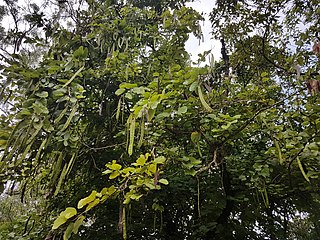
Bauhinia purpurea is a species of flowering plant in the family Fabaceae, native to the Indian subcontinent and Myanmar, and widely introduced elsewhere in tropical and subtropical areas of the world. Common names include orchid tree, purple bauhinia, camel's foot, butterfly tree, and Hawaiian orchid tree.

Bauhinia acuminata is a species of flowering shrub native to tropical southeastern Asia. Common names include dwarf white bauhinia, white orchid-tree and snowy orchid-tree. The exact native range is obscure due to extensive cultivation, but probably from Malaysia, Indonesia, and the Philippines.

Pericopsis elata is a species of flowering plant in the family Fabaceae and is known by the common names African teak, afromosia, afrormosia, kokrodua and assamela.
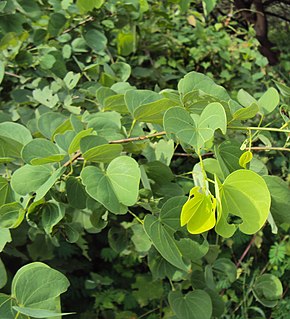
Piliostigma is a genus of flowering plants in the legume family, Fabaceae. It belongs to the subfamily Cercidoideae and the tribe Bauhinieae. It is dioecious, with male and female flowers on separate plants.

Bolusanthus speciosus is a species of flowering plants in the family Fabaceae. It belongs to the subfamily Faboideae. It is the only member of the genus Bolusanthus.

Telopea mongaensis, commonly known as the Monga waratah or Braidwood waratah, is a shrub or small tree in the family Proteaceae. Endemic to Australia, it grows at high altitude in south eastern New South Wales, where it is often seen in moist areas at the edge of rainforest or by streams in eucalyptus forests. Growing to 6 m (20 ft) high, it has narrow green leaves 4–18 cm (1.6–7.1 in) in length, and 0.5–2 cm (0.20–0.79 in) wide. In spring bears many red flowerheads, each made up of 28 to 65 individual flowers.
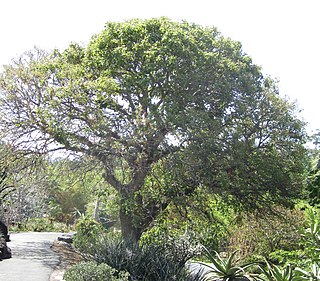
Erythrina abyssinica is a tree species of the genus Erythrina belonging to the plant family of the Fabaceae described by Augustin Pyramus de Candolle in 1825. This leguminous tree species is native to East Africa, Eastern DRC and southern Africa. In Zimbabwe its range overlaps with the similar Erythrina latissima.

Pentaclethra macroloba is a large and common leguminous tree in the genus Pentaclethra native to the wet tropical areas of the northern Neotropics, which can form monocultural stands in some seasonally flooded habitats. It has giant, bipinnate leaves shaped like feathers. It uses seed dispersal by water to establish itself in new areas, having floating seeds that are left behind after the waters recede after floods or tides. It has hard timber which is not very resistant to rot in the tropics, but it can be treated, has a pretty pink-red colour when dry, and has a number of uses. Oil used in cosmetics is extracted from the large seeds. In the northern Amazon region the bark is used in herbal medicine as an antivenom, and in the Guianas the bark has been used as a fish poison. Despite their toxicity, the seeds are eaten by variegated squirrels, parrots and macaws, and serve as the nurseries of the larvae of the moth Carmenta surinamensis.
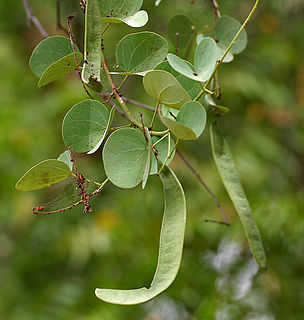
Bauhinia racemosa, commonly known as the bidi leaf tree, is a rare medicinal species of flowering shrub with religious significance. It is a small crooked tree with drooping branches that grows 3–5 metres (10–16 ft) tall and flowers between February and May. It is native to tropical Southeast Asia.

Afzelia quanzensis is a protected tree in South Africa. This deciduous tree can grow up to 20m in height, and has smooth, grey bark, which can flake in irregular patches. It has glossy dark green leaves and blooms between October and November. The flowers have one large red petal. After flowering, it produces a seed capsule, a thick wood-like pod, which contains black seeds with a hard, bright red aril covering one end.
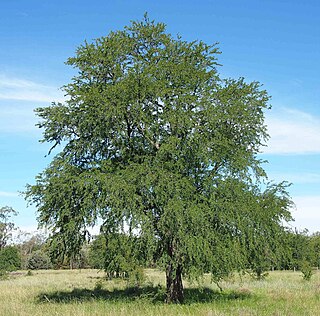
Lysiphyllum hookeri is a species of small tree endemic to Queensland, Australia, of the legume plant family Fabaceae. These trees are known by a variety of common names, including pegunny, alibangbang, Hooker's bauhinia, white bauhinia, mountain ebony and Queensland ebony.

Lysiphyllum cunninghamii is a species of plant in the family Fabaceae. It is native to northern Australia where it occurs from Western Australia through the Northern Territory to Queensland.
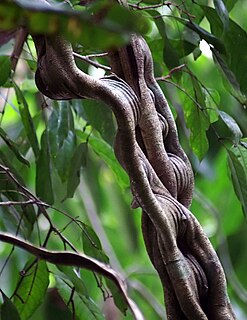
Bauhinia glabra, also commonly referred to as the monkey step/ladder, is more often introduced with its accepted name, whereas Bauhinia cumanensis, is a synonym for the plant name. B. glabra is located in the tropical climates of countries such as Venezuela, Trinidad and Tobago, Ecuador, Brazil, Costa Rica, Colombia and Guayana, while being introduced to Sri Lanka.




















